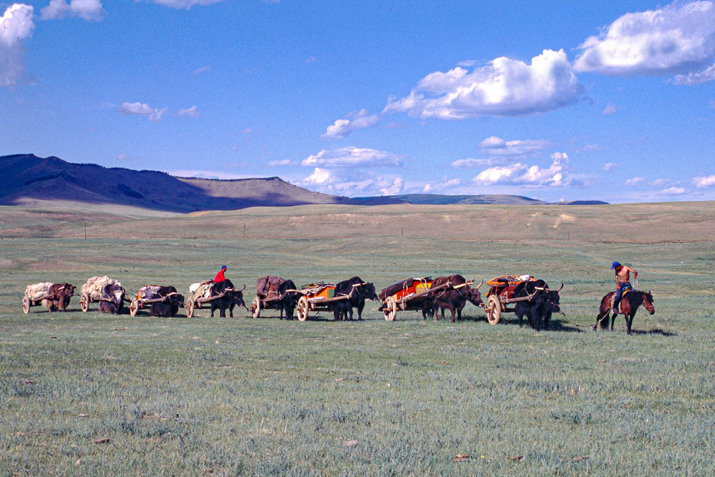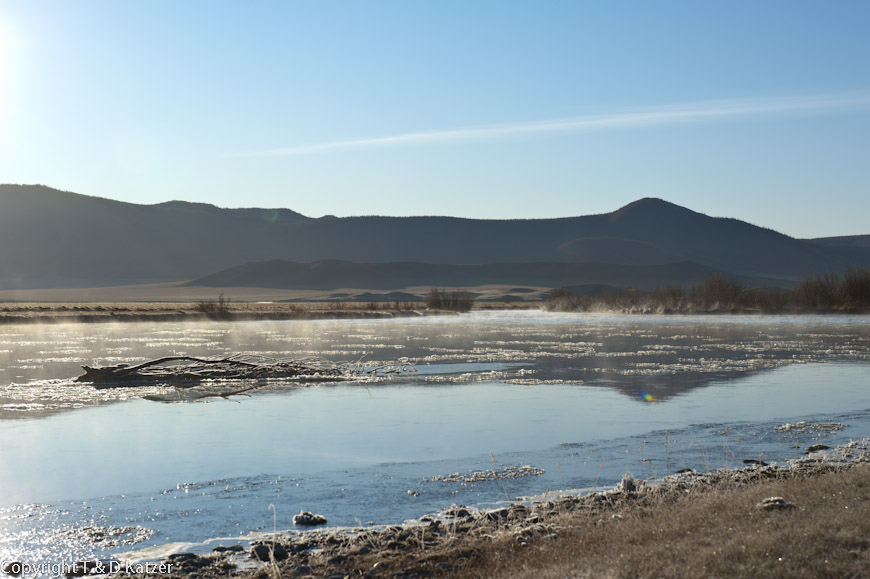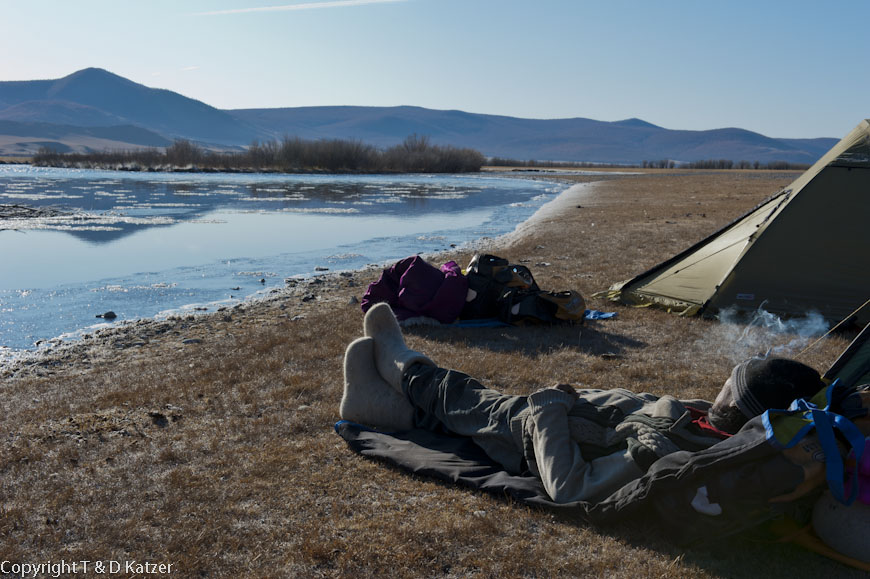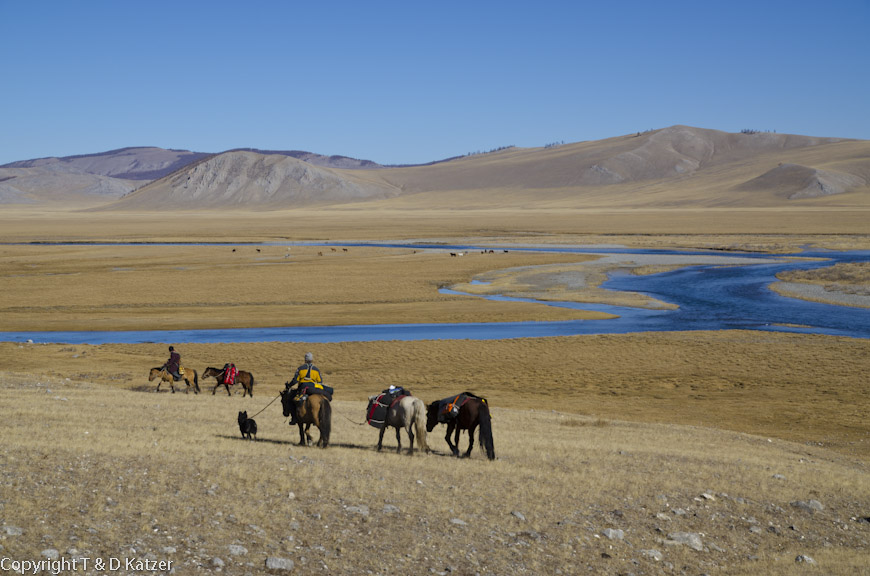
At rocky heights
N 50°21'856'' E 100°07'879''
Day: 92
Sunrise:
07:55
Sunset:
18:11
As the crow flies:
20,80
Daily kilometers:
30
Total kilometers:
894
Soil condition:
Meadow, scree, rocks, ice
Temperature – Day (maximum):
8°C
Temperature – day (minimum):
minus 3°C
Temperature – Night:
minus 20°C
Latitude:
50°21’856”
Longitude:
100°07’879”
Maximum height:
1850 m above sea level
Time of departure:
12:40
Arrival time:
18:15








We are woken up by the crunching, scraping and creaking of the ice floes rubbing against each other. The Egiyn Gol (Egiyn River) brings the icy masses of Khovsgol Nuur (Kkovgol Lake) down to us. As we leave the tent, the river steams in the morning sun. Although the water is around zero degrees, it must be downright warm compared to the outside temperature. The spectacle of the clashing temperatures reveals the upheaval the weather is undergoing. The daytime temperatures are still humane, but the nights are getting noticeably and rapidly colder.
Because we are camping right next to the watercourse, the ground is frozen as hard as concrete. The cold has even penetrated our sleeping mats, which is why we get up with stiff limbs. “Huaa it’s cold,” Tanja complains a little as she unzips the fabric house and is greeted by the warming rays of the morning sun. Bilgee and Tanja make a fire while I pack up our camp as usual. Bilgee is wearing his thick Mongolian felt shoes for the first time today. “You should have taken them with you too,” he says. Due to lack of space and because we had our warm monster shoes with us, we left them behind.
In the sun, temperatures rise above freezing. So we enjoy our breakfast. There is hot tea and cookies. Before Bilgee starts to take down his tent, he lies down on a couple of horse blankets, lights a cigarette and enjoys the moment. “We can really learn something there,” Tanja points to our horse man. “What do you mean?” I say as we are about to take down our tent. “Well look at him. He’s enjoying the moment. There’s no stress for him. We can learn something from his composure. And he won’t be any slower than us because of his break,” she says.
When I try to pull the tent pegs out of the ground, they don’t move an inch. “Man, these things are frozen!” I shout, first amused, then amazed and a little later annoyed. “No chance of getting them out,” I say to Tanja. I try to loosen it with the axe. The only thing that happens is to bend them completely without releasing them from their icy grip. Bilgee, who is now also taking down his tent, is struggling with the same challenge. “What a mess. Now the glove is torn!” I curse as I tug at one of the tent hooks like a madman. Without success. Our Bilgee takes two spare tent pegs, places them on the left and right of the frozen head of the tent peg and pulls on them. Lo and behold, it loosens and comes out of the ground. “The idea machine has struck again,” I say, shaking my head and wondering why I didn’t come up with this simple idea. Even if it is still very difficult to get the aluminum pins out of the substrate, it is now possible.
A shepherd appears out of nowhere. He talks to Bilgee and asks him about us and our trip. “What, you want to go to Tsagaan Nuur? Do you know what you’re doing there? It’s terribly cold there,” he says, shaking his entire body. “Well, that’s not exactly motivating,” says Tanja. “Nope, it’s not. If Mongolians are already scared of the cold, what can we say? Well, we’ll see. Let’s not get boxed in,” I reply, trying not to lose my confidence.
Again, we don’t set off until 12.40 p.m. and again the load slips after a short time. We stop like every day and adjust them. Then we set off on another steep climb. Because we follow the course of the river and it pushes through rough rock faces more often than we would like, we are forced to climb the mountain ridges that tower up in front of us. Usually only to ride on their flanks again on the other side. “Why don’t we just use the dust track? Surely cars and trucks also drive there? We’d make much faster progress and wouldn’t have to follow the meanders of the river,” I ask Bilgee, as the winter that is obviously approaching is really scaring me. “Not good. There’s no water next to the track,” he explains. “Hm, that makes sense. So we have to follow the Egiyn Gol and cross the mountains?” “Tijm” (“Yes”), he replies.
Whereas yesterday we thought we were on dangerous paths, today’s ride is an almost indescribable increase in danger. We ride directly along the side arm of the river on an embankment that slopes down to the water. The space available to us is getting narrower and narrower, so narrow that Sharga and Bor can no longer walk side by side. Bor, who is tied to Sharga’s neck, has to climb over increasingly thick boulders. We squirm like a reptile through and over the rough rock until we are trapped in a natural dead end. There is not enough space to turn the packhorses around. They would fall straight into the river. I sit nervously on Sar and look after Bilgee. Slowly he rides on. As the massive, steeply sloping rock face in front of us ends directly in the ice water of the Egyin, I wonder why Bilgee is riding even further into the scissor-like crevasse. “We should take a photo of that!” I shout to Tanja, who is right behind me. “Not a chance. I have enough to do with Naraa and Mogi,” she replies. The risk of taking out the SLR in the saddle to take a few photos is disproportionate to the risk of accidentally dropping it. It would undoubtedly smash on the rock below us. Suddenly Bilgee has disappeared from my field of vision. “He must have found a way around the rock needle,” I say to Tanja. Since I have no other choice, I urge Sar to keep walking slowly. When we reach the supposedly impassable rock face, I see a narrow mule track covered in rough rock. Dung tells me that it is also used by cattle. I carefully press my heels into Sar’s flank. Hesitantly and carefully, he put one hoof in front of the other and pushed his body past the sharp rock face. Sharga follows. The duffel bags scrape unpleasantly along the rock. Bor stumbles but catches himself. His load also scrapes against the rock. Before I know it, we’re through. The path widens a little. I see Bilgee waiting for us. A broad smile of recognition crosses his face. I immediately turn in the saddle. Tanja comes around the rock needle with a grin. “This is true adventure,” I hear her call out to me. “True adventure!” I reply, feeling my pulse beat.
However, there is no time to catch our breath. The horses’ legs stilt over a frozen hummocky landscape. As if a million moles had been digging here in a race. There is ice between the 15 to 20 centimeter high mounds. Treacherous ice. The hooves slip so much that I sometimes think my horse might fall. Sar, however, moves across the mine-like terrain like a figure skater. Apart from the rushing of the river and the loud cawing of a few crows, the land around us is silent. Yurts appear at the end of the now widening passage. Smoke rises from their chimneys. “Look at the sissies. They’re heating up!” I shout to Tanja and laugh at my own joke as if someone had told me a great joke. We pass a high frame made of wood. The inhabitants of this river valley probably keep their food there. Everything that wild dogs and possibly wolves should not get between their hungry teeth.
The valley opens up further and, one might think, spreads out its arms to welcome us into its heart. The Egiyn Gol meanders in several courses through the yellow-brown grass. Its dark blue stands out against the grass and the light blue, cloudless sky. We take in the beauty of nature in amazement. Inhale them properly. Even though I write about it almost every day, the rich variety of natural images of this wonderful country compels me to mention its beauty again and again.
Another mountain flank leans towards the river and only ends in its waters. Once again, we take on the challenge of avoiding the dead end. The higher we climb, the steeper the ascent becomes. So that Tanja can take a few photos, I take Mogi along with my two pack horses. “I’ll manage,” I say, running my mouth too full. “Don’t take any risks!” Tanja calls after me. “I’ll be careful,” I reply and steer Sar through the rough boulders. Sharga and Bor are finding it increasingly difficult to follow me. Boron stumbles over the coarse rock more and more often. While Mogi pulls on my left, the rope of the packhorses tightens on my right. In the meantime, we find ourselves in the middle of the rock. All around me were stones and rubble. “Watch out! Get off!” warns Tanja. Bilgee, who is about 50 meters above me, turns around in the saddle. Suddenly Sharga stops. The rope tightens, burns in my hand and almost pulls me out of the saddle. At the last moment I can stop Sar from climbing any further. With my heart pounding wildly, I get off my horse to continue the hair-raising ascent on foot. “Over there!” shouts Bilgee and points out a possible way through the rock. Never in my life would I have thought I could climb impassable mountains on horseback. It looks like the Mongolian horses must have something in common with chamois. Tanja comes up to us with Naraa in tow to take Mogi off my hands. Then I climb on. Always hoping that none of the horses will crash. Above me, I can only see light gray rocks emerging from the azure sky. Hoping that it won’t fall down a steep slope behind us, we head towards the top of the mountain. We only get closer to her slowly. The tension soon grows immeasurably. “Please let it fall flat behind the rocks,” I pray. Then I reach the top. Bilgee took a different route and climbed below us. “Does it go on up there?” he calls out. I look over the edge. “Tijm, (yes) looks very good,” I reply with relief. Before my eyes, the rock slopes down into a sloping meadow. No problem for us to get down there.
In the valley we meet another shepherd driving a large herd of sheep and goats in front of him. “Where are you from? Where are you going?”, we understand the usual questions. “We’re riding to Tsagaan Nuur,” I reply. “Tsagaan Nuur? You’d better not. It’s terribly cold there,” he says. To reinforce his statement, he shakes his whole body as if he had stuck two fingers into a socket without being able to pull them out again. “Man oh man. He’s probably exaggerating,” I say to Tanja, although I have to admit that I’m very impressed by his performance. I can only hope that he doesn’t scare off our Bilgee, as he is served the explanations in his own language. “Who knows? Everyone we meet talks about the terrible cold there,” Tanja replies. “Yes, yes, it may be cold. But they act like we’re riding straight into icy hell. Somehow that gets on your nerves. I’m sure it’s going to be very cold here too,” I reply, a little grumpily, as the constant warnings are starting to get on my nerves. Since people of all ages live in Tsagaan Nuur and they are certainly not superhumans, I have the feeling that they are exaggerating here. But perhaps it is also the case that things are always worse on the other side of the river than in your own village. The bad ones are always the others and they always live there and not here. At least that’s what people told us more than once during our travels. Maybe it’s the same here with the cold. “It’s bitterly cold there but it’s warm here”. What is strange, however, is that Tsagaan Nuur is no more than 150 kilometers away from here as the crow flies. And that can’t make all the difference in the world. Or is it?
“Choo! Choo! Choo!”, we spur our horses on and try to gain land after crossing the mountains. Once again, I think about the route ahead of us. Unsettled by the warnings, I calculate our marching performance so far. Not exactly a hit. We had planned seven to ten days to reach our destination. As things stand at the moment, we need 15 or 16 days. And here the path should still be good. But if the way over the mountains was good then I wonder what is bad? Maybe we’ll have to put our horses in a harness and rope them down? Or do we have to piggyback them and drag them up the mountain using our own physical strength? “Man oh man. They’re all exaggerating. The road can’t get any worse,” it goes through my head. “Choo! Choo! Choo!” I shout to keep the horses trotting. It’s been like this for hours now. The constant hopping is hard on the back and the intervertebral discs. “I’ve heard that riding is good for your back. Is that true?” I ask Tanja, who is trotting along beside me. “I can imagine.” “Somehow my intervertebral disc feels like it’s in a hammer mill. I don’t know if that’s good,” I reply.
Exposed to the wind on an open plain
With the last of the sunlight, we reach another valley. As usual, everything is absolutely bare. A herd of horses gallops across the dusty steppe. An icy wind whistles across it. At this moment, I am grateful to be wearing a Winterdeel. Bilgee wants to ride back to the opposite end. “That will be too late. It’s already bitterly cold. We should seek shelter behind the hut,” I say, pointing to an old wooden hut that is completely lost in the infinity. Bilgee is persuaded. Near the hut, right on the banks of the Egiyn Gol, we unload our brave animals. Everyone goes about their business without a word. Our camp is quickly set up. “Wow, that’s cold,” I say. “Maybe people aren’t exaggerating after all?” says Tanja. “By exaggerating, I don’t mean that they’re understating things, but that it’s not much colder there than it is here,” I reply.
Tanja complains of ice-cold toes. When Bilgee lights a small fire, she takes off her shoes and warms her feet by the flames. It’s 7 p.m. and the thermometer is already showing minus 15 degrees. Our camp is located in the center of a high valley. It narrows on one side behind us. The Egiyn Gol can just about squeeze through the incision. The wind is apparently accelerated there. At least it seems to us as if it is pushing itself through the constriction with the river and thus picking up speed. We are defencelessly at his mercy on the open plain. My toes also hurt like hell. I am aware that they are about to freeze to death. “It can happen very quickly,” we were warned back in Germany. “The onset of frostbite initially causes only slight discomfort and you may not notice it as the cold has an anaesthetic effect on the tissue. Remember that frostbite usually starts from minus 12 °C. But in unfavorable conditions such as strong wind, dampness or general hypothermia of the body, frostbite is possible even at around 0 °C,” I hear a doctor’s warning.
“And is it getting better? Is the feeling coming back?” I ask Tanja anxiously. “Yes, it’s getting better,” her reply reassures me. Because she is busy thawing her feet, I have taken over the cooking. “Look at that,” says Tanja, showing me her shoes. “Ice cream,” I say in amazement. “Yes, ice cream. And in my shoe,” she replies. “This means that the sweat is not transported to the outside but flows into the shoe where it freezes into ice. We just didn’t notice it because the inner shoe is made of synthetic fiber and doesn’t come into direct contact with the ice,” I conclude. I immediately take off my shoe and pull out the inner shoe. “That’s right. There’s water in there,” I say, amazed. Because I’m busy cooking, I quickly put it on again. But it feels like being in an icebox. After the water has boiled, I try to pour it into the thermos flasks. In vain. I can’t get the clasp open. “It’s frozen,” I say. “Pour hot water on it,” recommends Bilgee. “That’s a good idea,” I reply and lo and behold, I can now unscrew the cap. The wind suddenly exposes us to extreme conditions. Everything around us seems to freeze in a short space of time. All types of closures freeze shut as if they were sealed with superglue. Plastic breaks. Even the tea in our cup freezes if we don’t pour it in hot right away. I make the mistake of putting my spoon in my mouth after putting it down for a moment. It immediately freezes on my tongue. “Ah!” I’m startled, but he’s already free again. My tongue feels a little furry as a result. “You have to go and get some water,” says Tanja. “Oh dear. All right,” I groan and scurry down the embankment. The river has branched out here like spider webs into lots of little arms. Most of them are frozen over. In the cone-shaped light of my headlamp, my freezing feet tap across the slabs of ice to find an open spot. Then I dip a water bottle into the water with my bare hands. The pain is amazing. Freezing even more than before, I bring two bottles of water into camp, the contents of which we boil immediately and fill into thermos flasks and hot water bottles. Then, at minus 18 °C, we retire to the tents. Shivering, we undress. “At least we’re no longer exposed to the wind,” says Tanja. “Thank God,” I agree with her. I take my frozen inner shoes into the sleeping bag to thaw them out with body heat. A big mistake because they radiate so much cold that I can’t get my feet warm despite the hot water bottle. Then I try to bring my laptop up to operating temperature. It absorbs so much heat from my little hot water bottle that it is only lukewarm afterwards. I lie stiff as a board in my sleeping bag for an hour until I feel reasonably warm and get up to make my daily notes. Somehow I have the feeling that the documentation of this trip will soon be more exhausting than the trip itself. Bilgee is on guard duty while I’m typing away here. At 23:3o I have to go out for a quick dip. The thermometer, which I have attached to the tent fly, reads minus 20° C. This makes this night the coldest of our entire trip so far.
Only 10 minutes have passed since I closed my laptop and stowed it in my bag when Bilgee calls me to my watch shift. “Fucking guard shift,” I mutter. Shivering from the cold, I pull the head opening of the sleeping bag closed to the size of my fist. It couldn’t be smaller. Then I gather the ribbon that closes the down-filled fabric between my head and shoulders. This prevents cold air from reaching the body through the head opening. I peer through the small hole in the tent ceiling and my ears listen to the icy night. The headlamp is on and in the tent’s ceiling net. Its beam of light penetrates the fabric wall and can be seen by any thief from outside. So if a fearless and, from my point of view, crazy thief should actually come to steal our horses in these inhuman temperatures, he will see the light. The plan is to confuse or scare him off. Maybe he thinks someone in the tent is awake. At least I hope so. And if not, I don’t care now. To be honest, I’m suffering at the moment. Suffer from the cold that everyone has been talking about. And that must only be the beginning. “My God, I’ll be glad when we get to Tsagaan Nuur in one piece,” I whisper to myself and try to keep my eyes open until 2:30 in the morning. Then it’s Tanja’s turn. Your shift runs from 2:30 am to 5:00 am. Not a walk in the park either. It doesn’t matter which watch shift you’re on. Somehow they are all exhausting. Sometimes almost inhumanly exhausting.
We look forward to your comments!

